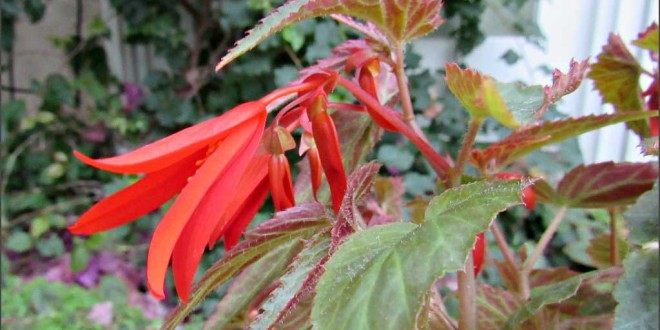The Santa Cruz Sunset begonia has dramatic angled petals. These plants fall into the tropical and subtropical category of perennials, growing well in U.S. Department of Agriculture plant hardiness zones 6 through 11. Many varieties with ornamental leaves and blossoms grow well outside in USDA zones 10 and 11, while hardy begonias survive winters in USDA zones 6 through 9 with proper care.
Planting Location:
Begonias enjoy fertile soil that has been amended with generous amounts of organic materials such as peat moss or well-rotted compost. The roots must have good drainage, or they can suffer from rot. These tropical perennials like partial shade. Exposure to strong sunlight burns the leaves and blossoms. Do not plant begonias in dense shade, because the plants grow more leaves than flowers. Begonias have brittle stems that are damaged by strong wind, so plant them in areas with wind protection.
Watering:
Begonias prefer high humidity, but not wet soil conditions. Let the top inch of the soil dry out before watering the plants. Do not mist the plant leaves. If the weather is hot and dry, water the area under the begonias so the evaporating moisture increases the humidity around the begonias.
Feeding:
Begonias respond well to occasional feeding. These plants prefer a balanced fertilizer such as 10-10-10. Granulated slow-release fertilizer scratched into the soil in the spring gives the begonias a source of slow-release nutrients throughout the growing season. Another option is to dilute water-soluble fertilizer to half strength, and feed the plants every 10 to 14 days.
Over-Wintering:
In mild winters without freezing temperatures, begonias grow throughout the winter. Many varieties will survive when planted in a protected area if the weather is frosty occasionally. For cold areas with freezing winters, dig up some of the begonias and transplant into containers. Store these in a cool area with good ventilation indoors. In the spring, take stem cuttings to propagate new begonias to plant outside. Tuberous begonias are commonly cut back to the ground before being dug up and stored in a box of peat moss for the winter.
Propagation:
Several varieties of begonias are propagated by planting fresh seeds in the spring. Stem cuttings taken in the spring or summer create a larger plant quicker than when planted by seed. Handling the cuttings includes dipping them into rooting hormone and placing them in damp peat moss. These cuttings are ready to plant outdoors when they start putting on new growth. Large clumps of begonias are divided into smaller plants in the spring.
Toxicity: The begonia plant’s juices and sap contain microscopic poisonous, needle-shaped crystals. All species of begonia are toxic to pets. If the animal consumes it, he will develop the common signs of poisoning, including drooling, difficulty swallowing, and vomiting. … The tubers are the most toxic component of the plant.
Family: Begoniaceae (be-gon-ee-AY-see-ee) (Info)
Genus: Begonia (be-GON-yuh) (Info)
Species: boliviensis (boh-liv-ee-EN-sis) (Info)
Cultivar: Santa Cruz Sunset
Classification:
Tuberous
Height:
12-18 in. (30-45 cm)
Spacing:
15-18 in. (38-45 cm)
18-24 in. (45-60 cm)
Hardiness:
Unknown – Tell us
Sun Exposure:
Full Sun
Sun to Partial Shade
Danger:
Unknown – Tell us
Bloom Color:
Red-Orange
Bloom Time:
Late Spring/Early Summer
Mid Summer
Late Summer/Early Fall
Mid Fall
Foliage:
Unknown – Tell us
Other details:
Unknown – Tell us
Soil pH requirements:
Unknown – Tell us
Patent Information:
Unknown – Tell us
Propagation Methods:
Unknown – Tell us
Seed Collecting:
Unknown – Tell us
Foliage Color:
Unknown – Tell us
Bloom Characteristics:
Unknown – Tell us
Water Requirements:
Drought-tolerant; suitable for xeriscaping
Average Water Needs; Water regularly; do not overwater
Where to Grow:
Suitable for growing in containers








